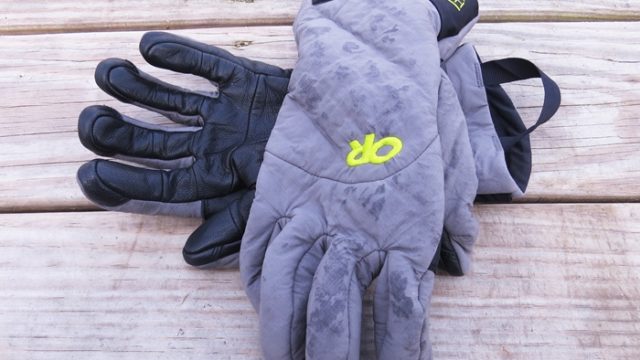There are certain “go to” companies for us; they’re the ones where we might not like everything they make for our own uses, but whatever products we’ve used from them have worked, and worked well. High on that list is Outdoor Research; from gaiters to gloves, shirts to shorts, we’ve never had a product fail us.

So, when we needed gloves that would allow us to take the photos we need with our phones without exposing bare skin to the elements, we looked and found the Outdoor Research Lodestar Sensor Gloves. In a lot of ways, they’re similar to the OR Stormchaser gloves that we’ve happily used for several years…but at the same time, there are some pretty dramatic differences.
Lodestar Sensor vs. Stormchaser: The Similarities
Let’s start with the similarities. Both are relatively lightweight (4.2 ounces/pair for the Stormchasers, 3.8 for the Lodestars), thin gloves with moderate insulation. These aren’t burly deep-cold gloves; they’re more designed to be used for active skiing, climbing, snowshoeing, or for putting on to clean your car off and then drive with until it warms up (hey, we’re practical…it’s not an “outdoors” use, but it’s the way we all have to live!).
They aren’t waterproof, seam-sealed, or anything like that, either; water resistant, but they aren’t designed (or priced) to be the ultimate miserable weather mitts. They’re both wind-resistant, with the Stormchaser using Gore Windstopper, the Lodestar using…we have no idea what. Something that OR decided to use that doesn’t carry a brand name label, and therefore not the brand name royalty fee, either. And, they’re both breathable, which is of major importance in a glove like this; fairly close fitting and used in aerobic activities means clammy if the water can’t get out easily.
And Then…The Differences

Differences? Let’s start with the “Sensor” label. The Lodestar allows you to use touchscreen devices without taking your gloves off. That’s an advantage in warmth, but also in speed; we’ve missed a lot of photos over the years due to the few-second lag in getting out gloves off. We’ve tried a number of touchscreen sensitive gloves over the years with varying results; the Lodestars were remarkably accurate in their ability to hit the screen where we wanted. One editor uses a Samsung S5 Mini because it fits in his pocket and is waterproof (he’s a klutz, always dropping it in snow or worse). The screen is TINY, and so are the icons, yet he found the Lodestars almost as easy to use as his bare finger. A definite win!
Second, wind resistance. We used the highly scientific “blow test” to determine this; it’s as bad as it sounds. Pick up the glove, put your mouth against the fabric, and blow as hard as you can. The Windstopper glove made us nearly pass out; the Lodestar allowed more air through. Definitely better wind resistance for the Stormchaser, but the Lodestar didn’t fare badly; it still had significant wind resistance. However, against all odds, when we tested them downhill skiing, the Lodestars were WARMER after downhill runs. We tried wearing one of each on opposite hands, and sure enough, it was clear to us that the hand with the Lodestar was more comfortable. We used a FLIR One thermal imaging camera to confirm that, and it indeed shows the Stormchaser releasing a lot more heat through the body of the glove. That’s an impressive showing for a lighter weight glove with less wind resistance.

Even more impressive is that the Lodestar is a gauntlet-style glove, which means it’s likely to be releasing more heat through the cuff area. Gauntlets are easier to get on and off, particularly when they’re damp inside, but typically aren’t quite as warm. In this case, it was a no-lose scenario; the Lodestar went on and off easily (thanks in part to OR’s wonderful Pull-On loops, which are large and easy to use), but clearly wasn’t losing heat. And even as a gauntlet style, it’s easy to use the Velcro tab at the wrist to tighten them down; we found it much simpler and more adjustable than the zipper on the Stormchaser.
Water resistance…well, let’s just say that was a tie, and neither is going to keep your hands dry for long in wet snow. Both did relatively well in falling snow, but they just plain aren’t designed for significant amounts of water. We did a version of our “torture test,” which usually requires 5 minutes submerged to qualify as waterproof; water was coming into both of these in 5 seconds. If you want waterproof, throw an OR overmitt like the Revel Shell Mitts on top of them.

Breathability was another win for the Lodestar. OR did something interesting with the insulation; instead of the fuzzy fleece being continuous, there are stitched areas about every 3/4″ with no insulation. We know that it’s thermally effective, but we also found that the gloves breathed well, with little clamminess except in very high aerobic use, and have to assume that it’s related to that design.
Finally, fit. Outdoor Research’s new “3D Fit Technology” involves multiple panels for each finger, and three panels for the palm…and it’s brilliant. Unless you’re doing karate chops, pretty much everything you’re likely to do with your hands involves the fingers being curved. This design means less material bunched up under your fingers and palm, meaning more comfort and a more secure grip when you’re grabbing poles, ropes, pack straps, whatever.
And The Champion Is…

Bottom line for us is that the Outdoor Research Lodestar Sensor Gloves are in virtually every way an improvement over our prior favorites. Add a liner glove, and they become significantly warmer, but they don’t NEED one to be comfortable. Add a liner and a shell, and they’re now functional to well down in the 20s (OR’s thermometer says they’re good for 0F to 20F, but we’re not at all sure what use that’s for; on their own, they were warm to the mid-20s when we were pretty active). They’re a great part of a system, or functional on their own, and they solved a lot of problems for us. Now, the only problem is getting them away from whoever is hoarding them at the moment!


